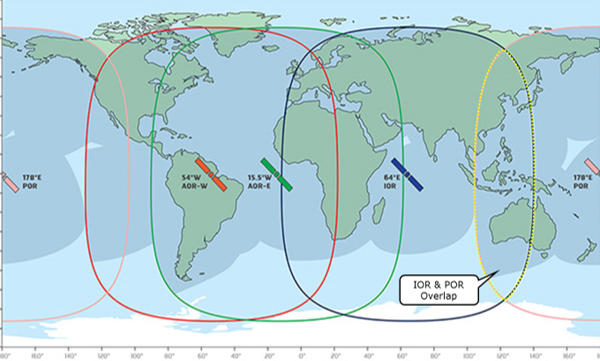
Global coverage of Inmarsat’s I3 network, showing the overlap region of the IOR and POR satellites
Last month, we published the complete logs for all communications that occurred on March 7 and 8, 2014, between the SATCOM unit aboard airframe 9M-MRO and the Inmarsat satellite network. (All times and days refer to UTC.) This includes communications before and during MH370 as well as the previous flight, MH371, between Beijing and Kuala Lumpur. Now that we’ve had a chance to investigate the logs for several weeks, I’ve summarized some of the findings. I’ve attempted to give proper credit to the individuals that worked on various aspects. If I have inadvertently omitted an individual, just let me know.
Observation: The log-on requests at 18:25:27 and 00:19:29 both had low carrier-to-noise-density (C/No) ratios, but normal receive power levels, indicating high noise levels. Similarly low (C/No) ratios were observed several times during MH371 under normal conditions. (Mike Exner)
Inference: The low (C/No) ratios at 18:25:27 and 00:19:29 were not likely due to abnormal aircraft maneuvers or attitudes.
Observation: When MH371 was traveling in a region of overlapping satellite coverage of the IOR and POR satellites, there were multiple automatic log-offs and log-ons with no indication of problems. (Many)
Inference: The multiple log-off and log-ons seen during MH371 are not indicative of a problem with the SATCOM.
Observation: An in-flight log-on does not produce abnormal values of BFO unless the log-on was part of power up sequence following an extended period during which the SATCOM was powered down. (Many)
Inference: This increases the likelihood that the SATCOM was unpowered for an extended period of time prior to the log-on at 18:25, and increases the likelihood that the abnormal BFOs during the log-on at 00:19 were due to an increasingly high rate of descent.
Observation: Abnormally high BTO values for a log-on request burst can be corrected with an offset of 4600 μs. (Many)
Inference: The corrected value of the BTO at 00:19:29 is 23000 – 4600 = 18400 μs, as previously suggested by Inmarsat. An adjustment to the position of the 7th arc does not seem to be warranted.
Observation: Abnormally high BTO values for a log-on acknowledge burst can be corrected with an offset of N*S, where N is an integer between 1 and 5, inclusive, and S=7812.5 μs. The value of S=7812.5 μs corresponds to the width of a slot, where a frame of 500 ms is comprised of 64 slots. (Don Thompson)
Inference: The corrected value of the BTO at 00:19:37 is 49660 – 4*7812.5 = 18410 μs, which statistically agrees with the corrected value of 18400 μs at 00:19:29. Again, an adjustment to the position of the 7th arc does not seem to be warranted.
Observation: Maintenance messages were generated after MH371 landed in Kuala Lumpur. However, no ACARS maintenance messages were generated during the flight. (@Andrew)
Inference: If a serious condition had arisen during MH371, it would have generated an ACARS message. Therefore, no serious condition arose during MH371.
Observation: When a 2nd log-on request message occurs one second after the first, it is related to initialization of the In-flight Entertainment System (IFE), and the message does not contain information about the Flight ID. If a 2nd log-on request does not occur, it suggests the IFE was not available at that time, possibly because the IFE has not yet completed its power up sequence. (Don Thompson)
Inference: This increases the likelihood that the IFE was unpowered prior to the log-on at 18:25 and unpowered prior to the log-on at 00:19.
Observation: During a log-on sequence, the SATCOM transmits a value for the “Prev Sat ID”. If the log-on occurs after a log-off request, or after a power interruption, the previous satellite value is cleared and a value of 63 (077) is transmitted. This value was transmitted for the log-on at 18:25 and the log-on at 00:19. There may be other causes for 63 to be transmitted that did not occur during MH371. (@el-gato, Don Thompson, and Richard Godfrey)
Inference: Since no log-off request was recorded prior to the log-ons at 18:25 and 00:19, it is likely that a power interruption preceded each of these log-ons.
Observation: Fuel flow data extracted from the ACARS reports for MH371 showed that the right engine burned fuel about 3.3% faster than the left during cruise. (Mike Exner, Don Thompson, Richard Godfrey)
Inference: If there was no fuel rebalancing by a pilot, the right tank for MH370 would have run dry about 15 minutes before the left tank.
Observation (preliminary): The measured values of BTO and BFO for MH371 agree with the BTO and BFO models that were used to reconstruct the flight path for MH370. (@sk999, Richard Godfrey)
Inference: The measured values of BTO and BFO for MH370 can be used to disqualify hypothetical paths with predicted values of BTO and BFO that do not match the measured values, as the ATSB and independent investigators have assumed.
In summary, the previous flight MH371 seems to have been normal in all respects. Using the satellite data from MH371, we have a higher level of confidence that for MH370, power was interrupted to the SATCOM prior to the log-ons at 18:25 and 00:19, and also higher level of confidence that the aircraft was in an increasingly steep descent at 00:19.
Considering that the newly available data generally supports the conclusions of the official investigators, it remains a mystery as to why Malaysia withheld the data for so long, and why it chose to release the data at this time.
I hope everybody is enjoying today, the Fourth of July, including Americans celebrating Independence Day.
